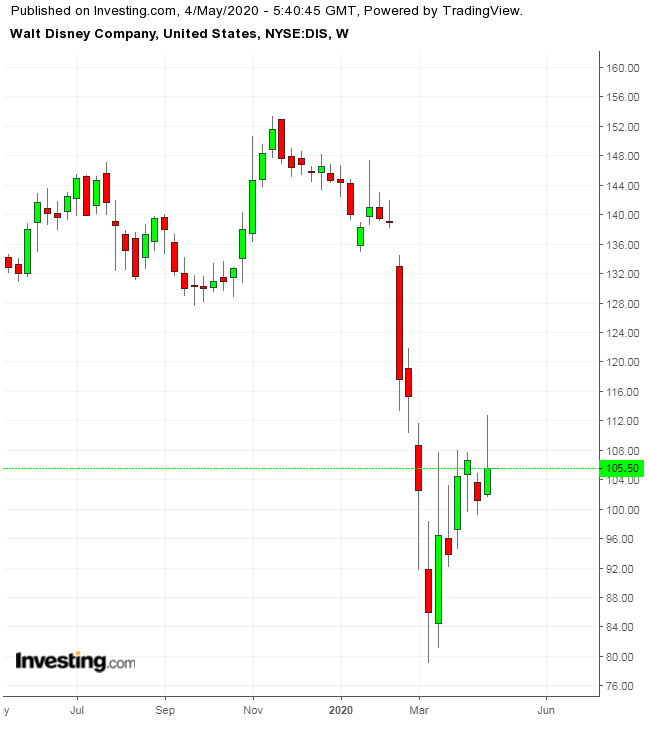- Reports Q2 2020 earnings on Tuesday, May 5, after the close
- Revenue Expectation: $18.05B
- EPS Expectation: $0.93
Shareholders of The Walt Disney Co. (NYSE:DIS) have plenty of reasons to worry right now. The Burbank, CA-based company's iconic theme parks are closed, film and TV production has shut down, and Disney's cruise ships are docked—all a result of the COVID-19 pandemic.
That means earnings for the fiscal 2020, second quarter will show an extraordinary slowdown and future guidance won’t carry much weight. According to one estimate, Disney is expected to report a steep drop in profit when it announces financial results on May 5. Earnings from resorts and consumer products may slump by $500 million or more in the period.

With fewer people willing to travel or take their families to anyplace crowded, Disney’s domestic park attendance—an estimated 83 million visitors last year—could fall by half in 2020, according to John Hodulik, a UBS analyst. Profit at the division may tumble to just $500 million this year and $200 million the next.
“The lingering effects of the Covid-19 outbreak will be felt for a number of years, and the parks segment is unlikely to regain previous thresholds for profitability until after a vaccine is widely available,” Hodulik said in an April 20 report, carried by Bloomberg. Last year, the segment accounted for 37% of the company’s $69.6 billion in total revenue.
Hurt by this huge damage to its business, Disney shares have fallen 27% this year. They closed Friday at $105.50, after falling 2.45% on the day.
Cost Cutting Plan
That sudden shift in the business environment requires the world’s largest media company to come up with a credible plan to get through this difficult phase. First, it has to show that it’s cutting costs as fast as revenues are falling.
Disney executives have already taken pay cuts and the company has put some 100,000 workers, mostly park employees, on unpaid furlough. Investors might see more cuts in tomorrow’s earning announcement.
Besides the spending cuts, investors will also be keen to know how Disney plans to reopen its operations in North America once the lockdowns are relaxed.
In an interview last month, Bob Iger, now Disney chairman, told Barron’s the company was considering taking guests’ temperatures as they enter parks. The Orange County Economic Recovery Task Force in Florida has suggested a two-phase plan for allowing visitors back into theme parks. The first phase would cap attendance at 50% capacity and the second phase would allow for 75% capacity once pandemic conditions improve.
These tentative plans certainly show it won’t be business as usual for the company for quite some time. Indeed, Disney is unlikely to reach its revenue peak until there is a vaccine to control the virus.
One bright spot: analysts expect a growing number of subscribers for the company’s newly launched streaming service, Disney+. The service had more than 50 million subscribers by early April, almost twice as many as Disney reported on February 4, after the service was rolled out in Europe and India.
The company may report another jump in these numbers as the work-from-home environment has further increased the demand for streaming services.
Bottom Line
Given that theme parks accounted for nearly 30% of Disney’s revenue last year and many of its upcoming films are now on hold, it's hard to see Disney coming out of this earnings recession anytime soon.
That said, Disney is a solid stock with a long history of surviving in some of the worst economic downturns. For these reasons, in our view it’s worth holding on to this name while the company rides out this tumultuous time.
